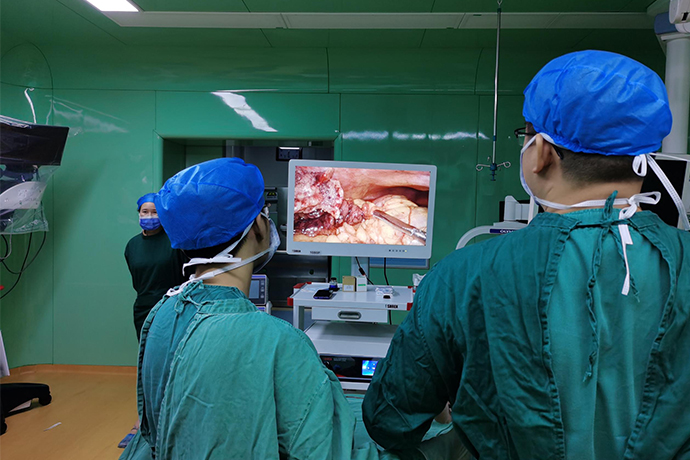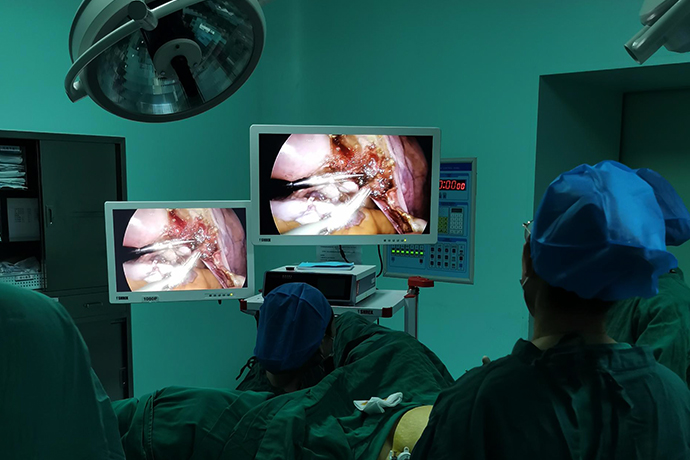【Gynecological Laparoscopy】Laparoscopic Accessory Resection
Release time: 28 Jul 2021 Author:Shrek
Laparoscopic accessory resection refers to laparoscopic removal of the affected fallopian tube and ovary.
Applicable disease
1. Patients over the age of 40 who have a unilateral ovarian benign tumor and a normal contralateral ovary.
2. Inflammatory adhesions or masses attached to the attachment for long-term repeated pelvic pain, and conservative treatment has failed.
3. Residual ovarian syndrome.
4. The ovarian cyst is large, there is basically no normal ovarian tissue or the ovarian cyst wall adheres closely to the normal ovary, the level is unclear, and it cannot be removed.
5. Patients with estrogen-dependent breast cancer.
6. Women with familial ovarian cancer syndrome should preventively remove their ovaries after giving birth.
7. Ovarian masses that persist after menopause.

Contraindications
Same as laparoscopic ovarian cyst removal.
Preoperative preparation
Same as preoperative preparation for ovarian cyst surgery.
Surgical steps and techniques
There are two methods of attachment removal: electrocoagulation, band ligation and so on.
1. Ligation
(1) Putting on the ferrule: Pass the No. 1 DJ wire through the knotter and tie it into a sliding coil, then put the inner ferrule on the same side through the sleeve sheath, put one side of the ferrule under the tumor, and then use it Hold the forceps and slide the other side of the coil along the surface of the cyst to the pedicle of the cyst. Note that the ovarian cyst and fallopian tube are outside the coil.
(2) Tighten the loop and knot, tighten the loop, ligate the funnel ligament of the pelvis, the fallopian tube and the proper ligament of the ovary, and tie the knot, which requires 2-3 times. Note that when the coil is tightened, the ligature is as close as possible to the pelvic wall and uterine corner.
(3) Removal of accessories: Cut off or electrocoagulate the pedicle at a distance of 0.5 to 1cm from the knot.
(4) Removal of accessories: The method is the same as that of ovarian cyst removal.
2. Electrocoagulation method
It is suitable for those who cannot be bandaged (such as those with a thick pedicle, or those with obvious edema and thickening of the broad ligament, or those with a long distance between the proper ovarian ligament and the suspensory ligament of the ovary).
(1) Use an ultrasonic knife or Ligasure to coagulate the pelvic funnel ligament, broad ligament, ovarian proper ligament, and fallopian tube isthmus.
(2) The method of removing accessories is the same as that of ovarian cyst removal.
Intraoperative risks and prevention
1. Damage to the intestines and ureters
Precautions:
① If the tumor adheres to the surrounding tissues, separate the adhesions before resection;
②When coagulating the suspensory ligament of the ovary, it is necessary to recognize the ureter, remove the left attachment, and be careful not to damage the sigmoid colon; ③If the ovarian cyst is large, first puncture and aspirate the sac fluid, suture or ligate the puncture port, and then remove it.
2. Bleeding
Slippage of the knot or the stump of the suspensory ligament of the ovary causes bleeding.
Precautions:
①When ligation is used to remove accessories, the distance from the knot when coagulating or cutting the pedicle is more than 0.5cm to prevent the knot from slipping off;
②For those who are not suitable for ligation, do not force ligation and use electrocoagulation;
③After coagulation of the ovarian suspension zone by electrocoagulation, the stump can be ligated with a coil to prevent late bleeding.

Applicable disease
1. Patients over the age of 40 who have a unilateral ovarian benign tumor and a normal contralateral ovary.
2. Inflammatory adhesions or masses attached to the attachment for long-term repeated pelvic pain, and conservative treatment has failed.
3. Residual ovarian syndrome.
4. The ovarian cyst is large, there is basically no normal ovarian tissue or the ovarian cyst wall adheres closely to the normal ovary, the level is unclear, and it cannot be removed.
5. Patients with estrogen-dependent breast cancer.
6. Women with familial ovarian cancer syndrome should preventively remove their ovaries after giving birth.
7. Ovarian masses that persist after menopause.

Contraindications
Same as laparoscopic ovarian cyst removal.
Preoperative preparation
Same as preoperative preparation for ovarian cyst surgery.
Surgical steps and techniques
There are two methods of attachment removal: electrocoagulation, band ligation and so on.
1. Ligation
(1) Putting on the ferrule: Pass the No. 1 DJ wire through the knotter and tie it into a sliding coil, then put the inner ferrule on the same side through the sleeve sheath, put one side of the ferrule under the tumor, and then use it Hold the forceps and slide the other side of the coil along the surface of the cyst to the pedicle of the cyst. Note that the ovarian cyst and fallopian tube are outside the coil.
(2) Tighten the loop and knot, tighten the loop, ligate the funnel ligament of the pelvis, the fallopian tube and the proper ligament of the ovary, and tie the knot, which requires 2-3 times. Note that when the coil is tightened, the ligature is as close as possible to the pelvic wall and uterine corner.
(3) Removal of accessories: Cut off or electrocoagulate the pedicle at a distance of 0.5 to 1cm from the knot.
(4) Removal of accessories: The method is the same as that of ovarian cyst removal.
2. Electrocoagulation method
It is suitable for those who cannot be bandaged (such as those with a thick pedicle, or those with obvious edema and thickening of the broad ligament, or those with a long distance between the proper ovarian ligament and the suspensory ligament of the ovary).
(1) Use an ultrasonic knife or Ligasure to coagulate the pelvic funnel ligament, broad ligament, ovarian proper ligament, and fallopian tube isthmus.
(2) The method of removing accessories is the same as that of ovarian cyst removal.
Intraoperative risks and prevention
1. Damage to the intestines and ureters
Precautions:
① If the tumor adheres to the surrounding tissues, separate the adhesions before resection;
②When coagulating the suspensory ligament of the ovary, it is necessary to recognize the ureter, remove the left attachment, and be careful not to damage the sigmoid colon; ③If the ovarian cyst is large, first puncture and aspirate the sac fluid, suture or ligate the puncture port, and then remove it.
2. Bleeding
Slippage of the knot or the stump of the suspensory ligament of the ovary causes bleeding.
Precautions:
①When ligation is used to remove accessories, the distance from the knot when coagulating or cutting the pedicle is more than 0.5cm to prevent the knot from slipping off;
②For those who are not suitable for ligation, do not force ligation and use electrocoagulation;
③After coagulation of the ovarian suspension zone by electrocoagulation, the stump can be ligated with a coil to prevent late bleeding.

- Recommended news
- 【General Surgery Laparoscopy】Cholecystectomy
- Surgery Steps of Hysteroscopy for Intrauterine Adhesion
- [Gynecological Hysteroscopy] Techniques for Preventing and Treating Complications of Hysteroscopic Surgery
- [Gynecological Hysteroscopy] Hysteroscopic Adhesiolysis
- [Gynecological Hysteroscopy] IUD Removal under Hysteroscopy